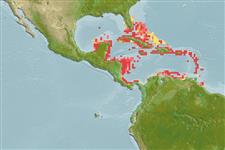>
Blenniiformes (Blennies) >
Blenniidae (Combtooth blennies) > Salariinae
Etymology: Entomacrodus: Greek, ento = inside + Greek, makros = big + Greek, odous = teeth (Ref. 45335).
More on author: Gill.
Environment: milieu / climate zone / depth range / distribution range
Ekologi
marina revassocierade; djupintervall 0 - 6 m (Ref. 9710), usually 0 - 3 m (Ref. 13628). Tropical; 32°N - 7°N, 92°W - 59°W
Western Atlantic: Bermuda, southern Florida (USA), and Bahamas to northern South America.
Size / Vikt / Age
Maturity: Lm ? range ? - ? cm
Max length : 10.0 cm TL hane/ej könsbestämd; (Ref. 7251)
Taggstrålar i ryggfenan (totalt) : 13; Mjukstrålar i ryggfenan (totalt) : 14 - 15; Taggstrålar i analfenan: 2; Mjukstrålar i analfenan: 15 - 17; Ryggkotor: 34. Olivaceous with 7 short dark brown double bars on side of body and rows of small pale blue spots (Ref. 13442).
Facultative air-breathing (Ref. 126274); Adults occur in intertidal areas (Ref. 31184), like tide pools, rocky slopes, and places where there are boulders on the bottom (Ref. 5521). Actively shuttle back and forth between rock-pools and air (Ref. 31184). They breathe air (Ref. 31184) and can remain out of water for up to 2 hours if kept moist (Ref. 51276). Feed mainly on algae (Ref. 13442). Oviparous. Eggs are demersal and adhesive (Ref. 205), and are attached to the substrate via a filamentous, adhesive pad or pedestal (Ref. 94114). Larvae are planktonic, often found in shallow, coastal waters (Ref. 94114).
Life cycle and mating behavior
Maturities | Reproduktion | Spawnings | Egg(s) | Fecundities | Larver
Oviparous, distinct pairing (Ref. 205).
Robins, C.R. and G.C. Ray, 1986. A field guide to Atlantic coast fishes of North America. Houghton Mifflin Company, Boston, U.S.A. 354 p. (Ref. 7251)
IUCN Red List Status (Ref. 130435)
Threat to humans
Harmless
Human uses
Fiskeri: saknar intresse; Akvarium: Kommersiell
Verktyg
Special reports
Download XML
Internet-källor
Estimates based on models
Preferred temperature (Ref.
123201): 26.5 - 28.2, mean 27.5 °C (based on 532 cells).
Phylogenetic diversity index (Ref.
82804): PD
50 = 0.5000 [Uniqueness, from 0.5 = low to 2.0 = high].
Bayesian length-weight: a=0.00741 (0.00335 - 0.01640), b=3.02 (2.83 - 3.21), in cm total length, based on LWR estimates for this (Sub)family-body shape (Ref.
93245).
Trofisk nivå (Ref.
69278): 2.0 ±0.0 se; based on diet studies.
Resiliens (Ref.
120179): Hög, lägsta populationsfördubblingstid mindre än 15 månader (Preliminary K or Fecundity.).
Fishing Vulnerability (Ref.
59153): Low vulnerability (10 of 100).
Nutrients (Ref.
124155): Calcium = 165 [80, 291] mg/100g; Iron = 0.868 [0.480, 1.563] mg/100g; Protein = 17.9 [16.7, 19.1] %; Omega3 = 0.0751 [, ] g/100g; Selenium = 20 [9, 47] μg/100g; VitaminA = 114 [27, 469] μg/100g; Zinc = 2.71 [1.75, 4.02] mg/100g (wet weight);
